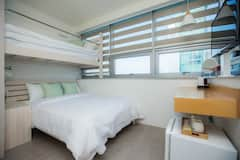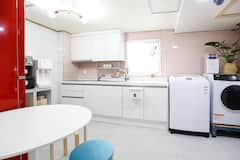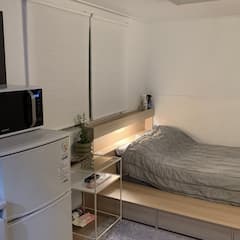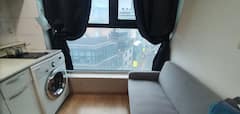Bathhouses in their traditional form are a very important part of Korean modern culture. It is common to see groups of people come to a jjimjilbang and participate in services that involve physical and mental relaxation. Koreans of all ages and gender are known to gather anytime in these places whenever they need to unwind, distress, and detox.
Instead of going out to drink, some groups of friends opt to relax in a bathhouse on a Friday or Saturday night. At times, family members come together and make this an activity where they can spend quality time together. This goes to show that anyone can experience an excellent time in a Korean public bathhouse.
Part of the culture of jjimjilbang is the separation of gender in the baths. For obvious reasons, males and females go inside separate bath areas. The reason for this is that all customers are required to take their clothes off. It would certainly be awkward for some to be seen without any clothing by members of the opposite sex. In other parts of the bathhouse, both men and women are allowed to congregate but with clothing supplied by the staff.
Bathhouses of today offer other service likened to what you will get in a spa. This includes massages and sauna rooms. Others extend their offerings by having their own restaurant and cafes where everyone can eat and have coffee or tea after.
History
The tradition of jjimjilbang has strong links to nature. The inspiration to create and simulate the natural effects of hot springs on the human body is what gave birth to the practice of providing soothing treatments in bathhouses. Today, natural elements play important roles in providing these services.
Just like in olden times, bathhouses are known to use materials like jade to heal joint illnesses and clay for detoxification. Nothing much has changed from then to now. However, the real origin of jjimjilbang remains uncertain. There are several stories that are believed to be the origin of Korean bathhouses. Among these, there are two that stand out.
The first story starts during the Joseon Dynasty. The royal documents called the ‘Sejong Sillok’ is believed to be where jjimjilbang was first mentioned. The records show that two people were sent to an establishment similar to jjimjilbang. Back in the 15th century, this place was called a Hanjeungso. The place was described as a small room with a lighted furnace and the floor sprinkled with water to create steam and humidity. The second story is about people entering kilns meant to bake charcoal or pottery to keep themselves healthy.
Jjimjilbang Etiquette

Entrance etiquette. As you enter, you take your footwear off and hide them in a small locker with a key by the entrance. Take the key and hand it to the front desk. You pay the fee and a new locker, located in the dressing area, will be given to you for you to keep your clothing. Along with this comes cotton pajamas and a towel. Dressing areas are labeled ‘nam’ for men, and ‘yeo’ for women.
Changing room etiquette. If you intend to use the sauna, you will have to wear the pajamas provided. If you intend to use the bath area, you have to take off all your clothing and proceed with the towel and necessary toiletries. Place your locker key around your wrist all the time.
The baths etiquette. Always wash completely using soap and shampoo before going to the tubs. Long haired people must tie their hair up. A 20-minute maximum stay is acceptable in most bathhouses. Body scrubs are available in both men’s and women’s baths and are facilitated by middle-aged people. They go hard at it but leave your skin very smooth.
Naked etiquette. It is normal to feel awkward for first timers and foreigners. However, Koreans are so used to seeing strangers in the buff in bathhouses. For people who are not used to being without clothing in a public place, the use of the towel is allowed, except when you plunge into the tub. Splashing water and loud talking are considered rude.
Sauna etiquette. Jjimjilbang saunas are different. These are kilns made from clay or stone and are heated to a maximum of 90 degrees Celsius (194 degrees Fahrenheit). This is a relaxing place especially since lying on hemp mats is a must. But to fall asleep is a dangerous thing because dehydration might set in since people here sweat a lot.
Sleeping room etiquette. Since bathhouses are open all day, they double as accommodations for customers who use the sleeping rooms to get some shut-eye. Some have simple beddings while others offer more comfortable ones. Guests can rent blankets even though these rooms are heated from under the floor. Normally, bathhouses allow guests to sleep for one night only. However, there are a few that let guests stay for more than that.
Check-out etiquette. Before checking out, take off the pajamas and get dressed. Hand the key to your locker to the front desk personnel and check the bill they will present to you. Simply pay the amount for any additional charges and you get your shoe locker key back. Put on your shoes and leave the key in the locker and that is it!
The best public bathhouses in Seoul

Dragon Hill Spa & Resort: Guests are attracted to the sauna which uses charcoal as a heating source with oak scent mixed into it. Dragon Hill encompasses seven levels filled with various bathhouse and spa treatments like a salt room, sauna, and baths.
Siloam Spa: Siloam Spa offers some of the best hot bath features, sauna treatments, and top quality traditional Korean food guests can partake of. The sleeping facilities here are known to be among the most comfortable in the industry.
Itaewon Land: Since it opened in 2003, Itaewon Land has become the most popular jjimjilbang among foreigners. It is also one of the most affordably priced bathhouses located in Seoul.
The Spa in Garden 5: This bathhouse is set in a tranquil and serene setting while offering a plethora of services ranging from baths, scrubs, and sauna treatments.
Spa Lei: This jjimjilbang is housed on three levels where one can experience various saunas, massage services, and baths.
You might be interested in these Airbnbs!
History
Get Trip101 in your inbox
Unsubscribe in one click. See our Privacy Policy for more information on how we use your data




















Create an account to